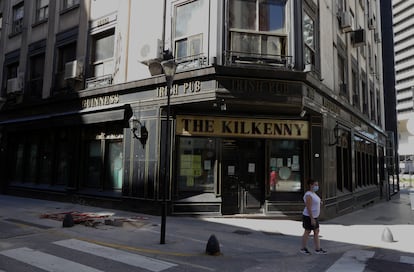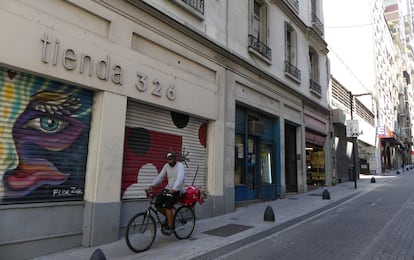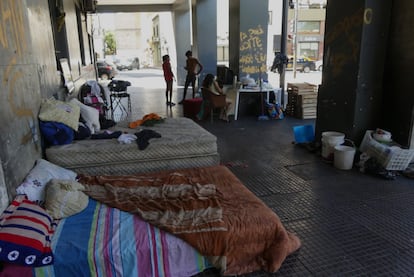Argentina’s perpetual crisis
A hundred years ago it was one of the richest countries in the world. Since then, it has suffered average annual inflation of 105% and has had to change currency five times. Where does the curse of the Argentine economy stem from?


Economic activity was devastated in Argentina during the fateful year of 2020. Official data records a 10% contraction, the largest decrease on the continent alongside Peru, if the Venezuelan catastrophe is not taken into account. In 2002, when Argentina collapsed, the fall was only slightly worse at 10.9%. Inflation is high (38.5% over the last 12 months and picking up), the peso continues to devalue, Central Bank reserves stand at less than $3 billion and four out of every 10 Argentines live below the poverty line. The macroeconomic outlook is alarming.
Argentina, though, is accustomed to bankruptcy and recovery. And to relative decline. Since 1921, when it was one of the richest countries in the world (GDP per capita at that time was on a par with France and Germany), Argentina has experienced average annual inflation of 105% and has been obliged to change its currency on five occasions: the peso moneda nacional until 1969, the peso ley from 1970 to 1983, the peso argentino until 1985, the austral until 1991 and the current peso, also known as the peso convertible. Since 1980 foreign debt payments have been suspended five times (no country in the world has defaulted the same number of times) and Argentina today is the main debtor of the International Monetary Fund (IMF) with $44 billion outstanding.
In December 2019, when the Peronist Alberto Fernández assumed the presidency, the economic landscape was not promising. Argentina had once again relapsed into the suspension of debt payments and the country had been mired in recession for three years. A few weeks later, the coronavirus pandemic struck, forcing Finance Minister Martín Guzmán into a battle on two fronts. On the one hand, via a series of lengthy telematic sessions, he renegotiated the country’s debt with private creditors and managed to come to an agreement over deferment of the payments with a notable reduction in interest rates. This provided some breathing space. Now Guzmán is attempting to persuade the IMF to also agree to a restructured schedule for the repayment of Argentina’s debt.
The other open front appears to be even more complex: how to subsidize businesses and citizens affected by the coronavirus lockdown. Lacking access to lending markets, Guzmán had to resort to simply printing money. The Central Bank issued 1.2 billion pesos in 2020, contracting money-printing presses in Brazil and Spain as both of Argentina’s were operational 24 hours a day and with the risk factor of inflation spiking further still, as seems now to be the case. Last January, prices rose by 4%.

Despite it all, Argentina continues to function. A good example of continuity in the face of all the difficulties the country has faced, past and present, can be found in Galfione and Co, a fabric spinning firm founded by Hugo Galfione in 1947 during the presidency of Juan Domingo Perón. Hugo’s grandson, Luciano Galfione, today runs the company. The Galfione family have overcome almost unthinkable hardships including hyperinflation and the barter system that came into being post-2001. Luciano Galfione pays 150 employees every month, oversees three factories and earns his living thanks to the domestic market.
The domestic market is one of the key elements in the difficulty Argentina experiences in maintaining sustainable growth and goes some way to explaining the formidable pressure applied by inflation: the country’s economy is not plugged into international commerce in any meaningful way. A comparison with Chile, a nation of 19 million inhabitants to Argentina’s 44 million, is sufficient to highlight the phenomenon. Chile’s exports stand at around $70 billion annually and imports come in at some $59 billion. Argentina exports a little over $60 billion in goods, mostly grain and meat, every year and its imports represent a similar amount. As Galfione jokes: “Look how rich the country could be, if only the Argentines would allow it.”
When Argentina emerged from its darkest dictatorship in 1984, Nobel Prize-winning economist Paul Samuelson put forward a similar idea, but without any hint of resigned humor: “Argentina is a classic example of an economy whose relative stagnation does not appear to be the consequence of climate, racial divisions, Malthusian poverty or technological shortcomings. It is its society, not its economy, that appears to be unwell.”
Alberto Fernández’s Peronist administration has laid the blame for the current crisis at the door of the government of his predecessor, Mauricio Macri (2015-19). It is true that during 2018 the peso lost 40% of its value and the huge loan received from the IMF evaporated in desperate coverage of the fiscal deficit and in speculative ventures (a large tranche of the $44 billion found its way into safes or ended up abroad). When the 2019 primaries pointed to a Peronist return to power, the stock market plunged, the peso devalued by a further 38% and exchange control mechanisms were reintroduced to prevent a collapse. But Macri in turn had inherited serious issues from his predecessor, Cristina Fernández de Kirchner, the current vice-president.

“It is an accumulation of crises,” says Diego Sánchez-Ancochea, Professor of Political Economy and Head of the Oxford Department for International Development. “Argentina has never managed to come out of its crisis. Its debt increased in the 1980s, in the 1990s it attempted to solve the problem through privatizations, then came the exchange rate crises of 2001 and 2002. There were periods of calm but the structural issues were never resolved. The crisis keeps returning because it never went away.”
One such endemic crisis it that of the peso. Decades of high inflation and the erosion of the currency’s value, coupled with the trauma of the 2001-02 corralito financial crisis when Argentines were unable to access their personal bank accounts for almost a year (and when they were, it was only to find that their dollar deposits had been exchanged for devalued pesos) have transformed Argentina into a dollarized country. Real estate prices, for example, are fixed in dollars.
“The dollar isn’t simply another variable, but a gauge of how the economy and politics are faring, as well as being a savings instrument,” says Marina Luzzi, co-author with Ariel Wilkis of El dólar: historia de una moneda argentina (or, The dollar: history of an Argentine currency). Argentina never managed to generate the amount of dollars it required which, according to Luzzi, makes exchange rate mechanisms a necessity (individuals are not allowed to buy more than $200 a month). The drop in tourist arrivals has exacerbated the lack of green bills in Argentina. The problem has become so serious that imports of high-end cars and expensive liquors has been banned.
On the other side of the coin, Argentina has been unable to find a solution to the historic contradiction between the requirements of its agriculture industry, the country’s primary source of dollars, which is highly competitive on the international market and therefore supportive of free trade, and industry, which since the first Perón term of 1946-55 at least has operated under a protectionist, verging on autarchic, logic that can be summed up by a phrase Peronists still repeat today: “Live by what is ours.”
The “raw materials curse”
“Argentina suffers from a unique curse in terms of raw materials originating in its agriculture sector,” says Douglas Southgate, Emeritus Professor in the Department of Agricultural, Environmental, and Development Economics at Ohio State University. “The sector, which enjoys a strong competitive advantage, employs few workers and the best rural land is concentrated in the hands of relatively few people. As a consequence, agriculture is a favorite target for taxes designed by politicians whose voters are employed in other economic sectors. This taxation of the Argentine agricultural sector results in the chronic underperformance of the national economy, which in turn leads to frequent and severe crises.”
Directly or indirectly, Argentine agriculture employs over two million people, or 14% of the working population, yet contributes only 10% of GDP. Its real strength, and the root of its conflicts with Peronism over withholding taxes at source, lies in its competitiveness. For every $10 Argentina banks through exports, $7 comes from agriculture. Without agricultural exports, Argentina would garner scarcely any foreign currency.
Luciano Galfione has his own view on the matter: “My grandfather Hugo, who founded the company, had land in Santa Fe, in Recreo, the most expensive area and the most productive; the soybean basket of Argentina. Then someone came along in 1947 and said the future was in industry so he sold all his land and came to Buenos Aires to start a factory making hosiery. If I saw him today I’d give him a good hiding. But in all seriousness, he wasn’t misguided because there isn’t a developed country in the world that isn’t an industrial power.”

The problem is that Argentina never became an industrial power. It gambled heavily on a policy of import substitution and from the middle of the 20th century it was producing all manner of items so as not to have to buy them from overseas. That was the formula prescribed by the United Nations Economic Commission for Latin America and the Caribbean to the continent as a whole to develop national economies and balance their trade and current accounts. Argentine industry was fostered and protected until the dictatorship of 1976 ended that policy. “The logic of industry died with the military,” says Galfione.
In 1976, when the world was engulfed by petroleum shortages brought about by the energy crises, Argentine GDP rose to $51 billion and South Korea’s to $30 billion. Today, the Argentine economy weighs in at about $80 billion annually. In South Korea, where half a century ago industrialization was accelerated on the back of draconian labor market conditions and widespread exchange market manipulation, annual GDP stands at $1.6 trillion and its export market is almost unparalleled globally.
What happened in Argentina? Galfione also has an explanation, based on first-hand experience. In 2016, he attempted to embark on a project using nanotechnology to make fabrics with a specialized crystalline structure resistant to heat, insects and bacteria. He applied for public funding from the Macri government but was refused. “I don’t have any machines that are not equal to or better than any others in any part of the world and my productiveness is world-class. What’s killing me are costs. China and India sell at rates lower than the cost of the raw materials. I’m cheaper than Spain or Italy, but they now produce their goods in the Far East,” he says.
To that, says Galfione, can be added other problems based on the price of energy and transport. “Transport costs are huge. It works out cheaper to send a container to China than it does to bring a truck here from Catamarca.” The result is a dense industrial fabric but, in general, one that remains incapable of competing with other countries. Without external competition due to a lack of imports – customs tariffs are prohibitive – Argentina’s output tends toward mediocrity. Those sectors that do possess high technological capabilities (genetic modification, nuclear energy, pharmaceutics) are not sufficient to raise the overall average level and there is an ongoing talent drain seeking opportunities overseas.
“There is something fundamental, and that is a lack of consistency in macroeconomic policies,” says Néstor Castañeda, Associate Professor of Latin American Political Economy at University College London and a member of the Institute of the Americas. “The production structure is very unbalanced and it requires external sources of financing. Everything depends on foreign currency coming in from abroad. Every time there is a contraction in global commerce or there is a decrease in the amount of foreign investment, a problem arises in terms of reserves. There is no way to resolve it. On the one hand, Argentina fails to meet its debt repayments and therefore finds its access to lending markets limited, and on the other there is a lack of coordination between exchange rate, fiscal and monetary policies. There can be 10 years of growth and then it all comes apart and it’s back to square one again.”
The 1980s tend to be considered a “lost decade” for the Argentine economy. The dictatorship made way for democracy under Raúl Alfonsín but hyperinflation came with it. In 1989 alone, prices rose by 3,000%. In his hosiery factory, Luciano Galfione’s father didn’t measure by pesos but by kilos, because determining the monetary value of a product was impossible. However, taking into account macroeconomic evolution and despite the easy-money rush of the 1990s when a peso was equivalent to a dollar under Carlos Menem’s government, and leaving aside the golden years of Néstor Kirchner (2003-07) when courtesy of a brutal cleansing forced by the crash of 2001-02 and a rise in soya prices significant growth with low inflation was achieved, Argentina has several lost decades on its books.
Economist Martín Rapetti estimates that, in real terms, Argentina’s per capita GDP is today almost the same as it was in 1974, with the additional problem of inequality between the rich and the poor being considerably greater. Half a century lost. In an interview with Clarín, Rapetti made a sobering prediction: on the assumption that the Argentine economy grows by a projected 6% in 2021 and continues to add 4.5% a year at a continuous, uninterrupted rate, which is highly unlikely, the standard of living experienced in 2011 will not be reached again until 2027.
Mar Centenera, Federico Rivas Molina and Ignacio Fariza contributed to this story.
English version by Rob Train.

